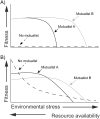Orienting the Interaction Compass: Resource Availability as a Major Driver of Context Dependence
- PMID: 27732591
- PMCID: PMC5061325
- DOI: 10.1371/journal.pbio.2000891
Orienting the Interaction Compass: Resource Availability as a Major Driver of Context Dependence
Abstract
Life on earth is enormously diverse, in part because each individual engages in countless interactions with its biotic and abiotic environment during its lifetime. Not only are there many such interactions, but any given interaction of each individual with, say, its neighbor or a nutrient could lead to a different effect on its fitness and on the dynamics of the population of which it is a member. Predicting those effects is an enduring challenge to the field of ecology. Using a simple laboratory system, Hoek and colleagues present evidence that resource availability can be a primary driver of variation between interactions. Their results suggest that a complex continuum of interaction outcomes can result from the simple combined effects of nutrient availability and density-dependent population dynamics. The future is rich with potential to integrate tractable experimental systems like theirs with hypotheses derived from studies of interactions in natural communities.
Conflict of interest statement
The authors have declared that no competing interests exist.
Figures


Similar articles
-
The Genetics Underlying Natural Variation in the Biotic Interactions of Arabidopsis thaliana: The Challenges of Linking Evolutionary Genetics and Community Ecology.Curr Top Dev Biol. 2016;119:111-56. doi: 10.1016/bs.ctdb.2016.03.001. Epub 2016 Apr 23. Curr Top Dev Biol. 2016. PMID: 27282025 Review.
-
Predator-Prey Interactions are Context Dependent in a Grassland Plant-Grasshopper-Wolf Spider Food Chain.Environ Entomol. 2015 Jun;44(3):519-28. doi: 10.1093/ee/nvv033. Epub 2015 Mar 29. Environ Entomol. 2015. PMID: 26313957
-
Prediction of Neighbor-Dependent Microbial Interactions From Limited Population Data.Front Microbiol. 2020 Jan 21;10:3049. doi: 10.3389/fmicb.2019.03049. eCollection 2019. Front Microbiol. 2020. PMID: 32038529 Free PMC article.
-
The ecology of individuals: incidence and implications of individual specialization.Am Nat. 2003 Jan;161(1):1-28. doi: 10.1086/343878. Epub 2002 Dec 11. Am Nat. 2003. PMID: 12650459
-
When less is more: positive population-level effects of mortality.Trends Ecol Evol. 2014 Nov;29(11):614-24. doi: 10.1016/j.tree.2014.08.006. Epub 2014 Sep 25. Trends Ecol Evol. 2014. PMID: 25262501 Review.
Cited by
-
The evolutionary ecology of bird-ant interactions: a pervasive but under-studied connection.Proc Biol Sci. 2024 Jan 10;291(2014):20232023. doi: 10.1098/rspb.2023.2023. Epub 2024 Jan 3. Proc Biol Sci. 2024. PMID: 38166423 Free PMC article. Review.
-
Co-occurrence in ant primary parasitoids: a Camponotus rectangularis colony as host of two eucharitid wasp genera.PeerJ. 2021 Aug 18;9:e11949. doi: 10.7717/peerj.11949. eCollection 2021. PeerJ. 2021. PMID: 34466288 Free PMC article.
-
Impact of habitat loss on the diversity and structure of ecological networks between oxyurid nematodes and spur-thighed tortoises (Testudo graeca L.).PeerJ. 2019 Dec 2;7:e8076. doi: 10.7717/peerj.8076. eCollection 2019. PeerJ. 2019. PMID: 31824759 Free PMC article.
References
MeSH terms
Grants and funding
LinkOut - more resources
Full Text Sources
Other Literature Sources

